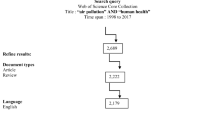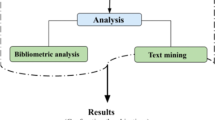Abstract
A bibliometric analysis based on Web of Science was carried out to provide a critical analysis of the literature on atmospheric pollution sources during 2006–2015. The result showed that particulate matter represented the core of this research field, and methods of source apportionment such as positive matrix factorization were the mainstream techniques. Five clusters were identified from the keywords network with central node of particulate matter, traffic, heavy metal, elemental carbon and renewable energy respectively. The hotspots and their relationships were illustrated to describe the characteristics of this research field. The USA and China took the leading position, however, their research emphasis were health effect and characteristics of pollutants respectively. International collaboration was mostly conducted within Asia–Pacific countries, and EU countries. For journals, Atmospheric Environment was most productive during the study period while Environmental Science and Technology had highest impact factor in 2015. This study provides an effective approach to obtain a general knowledge of the atmospheric pollution sources and supports a deeper understanding of research directions in the future.










Similar content being viewed by others
Notes
Author Keywords (hereafter referred to as keywords) are a list of terms provided by original authors to best represent the content of their paper. As a reliable indicator of the gist in the article, the author keywords were selected for SNA to reveal the hotspots of the research filed in this study.
References
Andreae, M. O. (2001). Emission of trace gases and aerosols from biomass burning. Global Biogeochemical Cycles, 15(4), 955–966.
Araujo, J. A., & Nel, A. E. (2009). Particulate matter and atherosclerosis: Role of particle size, composition and oxidative stress. Particle and Fibre Toxicology, 6(1), 1–19.
Cançado, J. E., Saldiva, P. H., Pereira, L. A., Lara, L. B., Artaxo, P., Martinelli, L. A., et al. (2006). The impact of sugar cane-burning emissions on the respiratory system of children and the elderly. Environmental Health Perspectives, 114(5), 725–729.
Chow, J. C. (1999). Welcome to a special issue on PM25: A fine particle standard. Journal of the Air and Waste Management Association, 49(9), 1.
Chow, W. K., & Chan, M. Y. (2003). Field measurement on transient carbon monoxide levels in vehicular tunnels. Building and Environment, 38(2), 227–236.
Cobo, M. J., López-Herrera, A. G., Herrera-Viedma, E., & Herrera, F. (2011). An approach for detecting, quantifying, and visualizing the evolution of a research field: A practical application to the Fuzzy sets theory field. Journal of Informetrics, 5(1), 146–166.
Colvile, R. N., Hutchinson, E. J., Mindell, J. S., & Warren, R. F. (2001). The transport sector as a source of air pollution. Atmospheric Environment, 35(9), 1537–1565.
Feng, Y., Chen, Y., Guo, H., Zhi, G., Xiong, S., Li, J., et al. (2009). Characteristics of organic and elemental carbon in PM 2.5 samples in Shanghai, China. Atmospheric Research, 92(4), 434–442.
Ferm, M. (1998). Atmospheric ammonia and ammonium transport in Europe and critical loads: A review. Nutrient Cycling in Agroecosystems, 51(1), 5–17.
Fu, H. Z., Wang, M. H., & Ho, Y. S. (2013). Mapping of drinking water research: a bibliometric analysis of research output during 1992–2011. Science of the Total Environment, 443(3), 757–765.
Gao, J., Tian, H., Cheng, K., Lu, L., Zheng, M., Wang, S., et al. (2015). The variation of chemical characteristics of PM 2.5 and PM 10 and formation causes during two haze pollution events in urban Beijing. China Atmospheric Environment, 107, 1–8.
Gulland, A. (2014). One in eight deaths is due to air pollution, says WHO. BMJ British Medical Journal, 348(18), 1255.
Hou, X., Zhuang, G., Sun, Y., & An, Z. (2006). Characteristics and sources of polycyclic aromatic hydrocarbons and fatty acids in PM 2.5 aerosols in dust season in China. Atmospheric Environment, 40(18), 3251–3262.
Iii, C. A. P., Burnett, R. T., Thun, M. J., Calle, E. E., Krewski, D., Ito, K., et al. (2002). Lung cancer, cardiopulmonary mortality, and long-term exposure to fine particulate air pollution. JAMA, the Journal of the American Medical Association, 287(9), 1132–1141.
Kang, C. M., Lee, H. S., Kang, B. W., Lee, S. K., & Sunwoo, Y. (2004). Chemical characteristics of acidic gas pollutants and PM2.5 species during hazy episodes in Seoul, South Korea. Atmospheric Environment, 38(28), 4749–4760.
Kauffman, J., Kittas, A., Bennett, L., & Tsoka, S. (2014). DyCoNet: A gephi plugin for community detection in dynamic complex networks. PLoS One, 9(7), e101357.
Kelly, F. J., & Fussell, J. C. (2012). Size, source and chemical composition as determinants of toxicity attributable to ambient particulate matter. Atmospheric Environment, 60(11), 504–526.
Kolle, S. R., & Shnakarappa, T. H. (2016). Global research on air pollution between 2005 and 2014: A bibliometric study. Collection Building, 35(3), 84–92.
Kongtip, P., Thongsuk, W., Yoosook, W., & Chantanakul, S. (2006). Health effects of metropolitan traffic-related air pollutants on street vendors. Atmospheric Environment, 40(37), 7138–7145.
Künzli, N., Kaiser, R., Medina, S., Studnicka, M., Chanel, O., Filliger, P., et al. (2000). Public-health impact of outdoor and traffic-related air pollution: A European assessment. Lancet, 356(9232), 795–801.
Lamarque, J. F., Bond, T. C., Eyring, V., & Granier, C. (2010). Historical (1850–2000) gridded anthropogenic and biomass burning emissions of reactive gases and aerosols: methodology and application. Atmospheric Chemistry and Physics, 10(15), 7017–7039.
Lee, S., Liu, W., Wang, Y., Russell, A. G., & Edgerton, E. S. (2008). Source apportionment of PM 2.5: Comparing PMF and CMB results for four ambient monitoring sites in the southeastern United States. Atmospheric Environment, 42(18), 4126–4137.
Liu, B. (2015). Impact on rubber oils by the PAHs control requirements of new policies and the development of green tires. Guangdong Chemical Industry, 42, 1–4. (in Chinese).
Lonati, G., & Giugliano, M. (2006). Size distribution of atmospheric participate matter at traffic exposed sites in the urban area of Milan (Italy). Atmospheric Environment, 40(2), 264–274.
Marlier, M. E., Jina, A. S., Kinney, P. L., & Defries, R. S. (2016). Extreme air pollution in global megacities. Current Climate Change Reports, 2(1), 15–27.
Nemet, G. F., Holloway, T., & Meier, P. (2010). Implications of incorporating air-quality co-benefits into climate change policymaking. Environmental Research Letters, 5(1), 75–82.
Nordling, E., Berglind, N., Melen, E., Emenius, G., Hallberg, J., Nyberg, F., et al. (2008). Traffic-related air pollution and childhood respiratory symptoms, function and allergies. Epidemiology, 19(3), 401–408.
Obrist, D., Hallar, A. G., Mccubbin, I., Stephens, B. B., & Rahn, T. (2008). Atmospheric mercury concentrations at Storm Peak Laboratory in the Rocky Mountains: Evidence for long-range transport from Asia, boundary layer contributions, and plant mercury uptake. Atmospheric Environment, 42(33), 7579–7589.
Ohara, T., Akimoto, H., Kurokawa, J., Horii, N., Yamaji, K., Yan, X., et al. (2007). An Asian emission inventory of anthropogenic emission sources for the period 1980–2020. Atmospheric Chemistry and Physics, 7(16), 6843–6902.
Panwar, N. L., Kaushik, S. C., & Kothari, S. (2011). Role of renewable energy sources in environmental protection: A review. Renewable and Sustainable Energy Reviews, 15(3), 1513–1524.
Peng, R. D., Bell, M. L., Geyh, A. S., Mcdermott, A., Zeger, S. L., Samet, J. M., et al. (2009). Emergency admissions for cardiovascular and respiratory diseases and the chemical composition of fine particle air pollution. Environmental Health Perspectives, 117(6), 957–963.
Russow, R., Spott, O., & Stange, C. F. (2008). Evaluation of nitrate and ammonium as sources of NO and N2O emissions from black earth soils (Haplic Chernozem) based on 15 N field experiments. Soil Biology & Biochemistry, 40(2), 380–391.
Salo, H., Bućko, M. S., Vaahtovuo, E., Limo, J., Mäkinen, J., & Pesonen, L. J. (2012). Biomonitoring of air pollution in SW Finland by magnetic and chemical measurements of moss bags and lichens. Journal of Geochemical Exploration, 115, 69–81.
Schichtel, B. A., Husar, R. B., Falke, S. R., & Wilson, W. E. (2001). Haze trends over the United States, 1980–1995. Atmospheric Environment, 35(30), 5205–5210.
Shi, G., Yang, L., Wang, Y., Kazuhiko, K., Zhu, J., Tang, H., et al. (2009). Impact of elevated ozone concentration on yield of four Chinese rice cultivars under fully open-air field conditions. Agriculture, Ecosystems & Environment, 131(3–4), 178–184.
Shukla, S. P., & Sharma, M. (2008). Source apportionment of atmospheric PM 10 in Kanpur, India. Environmental Engineering Science, 25(6), 849–861.
Sicard, P., Lesne, O., Mangin, A., & Alexandre, N. (2011). Notice of retraction air quality trends and potential health effects: Development of an aggregate risk index. Atmospheric Environment, 45(5), 1145–1153.
Simoneit, B. R. T., Schauer, J. J., Nolte, C. G., Oros, D. R., Elias, V. O., Fraser, M. P., et al. (1999). Levoglucosan, a tracer for cellulose in biomass burning and atmospheric particles. Atmospheric Environment, 33(2), 173–182.
Singer, B. C., Hodgson, A. T., Hotchi, T., & Kim, J. J. (2004). Passive measurement of nitrogen oxides to assess traffic-related pollutant exposure for the East Bay children’s respiratory health study. Atmospheric Environment, 38(3), 393–403.
Singh, S., & Agrawal, S. B. (2009). Use of ethylene diurea (EDU) in assessing the impact of ozone on growth and productivity of five cultivars of Indian wheat (Triticum aestivum L.). Environmental Monitoring and Assessment, 159(1–4), 125–141.
Sun, Y. L., Jiang, Q., Wang, Z. F., Fu, P. Q., Li, J., Yang, T., et al. (2014). Investigation of the sources and evolution processes of severe haze pollution in Beijing in January 2013. Journal of Geophysical Research Atmospheres, 119(7), 420–425.
Sun, Y., Zhuang, G., Tang, A. A., Wang, Y., & An, Z. (2006). Chemical characteristics of PM2.5 and PM10 in Haze–Fog episodes in Beijing. Environmental Science and Technology, 40(10), 3148–3155.
Van, D. A., Martin, R. V., Brauer, M., & Boys, B. L. (2015). Use of satellite observations for long-term exposure assessment of global concentrations of fine particulate matter. Environmental Health Perspectives, 123(2), 135–143.
Wang, F., Jia, X., Wang, X., Zhao, Y., & Hao, W. (2016). Particulate matter and atherosclerosis: A bibliometric analysis of original research articles published in 1973–2014. BMC Public Health, 16(1), 1–8.
Wang, M. H., Yu, T. C., & Ho, Y. S. (2010). A bibliometric analysis of the performance of water research. Scientometrics, 84(3), 813–820.
Xie, S. D., Zhang, J., & Ho, Y. S. (2008). Assessment of world aerosol research trends by bibliometric analysis. Scientometrics, 77(1), 113–130.
Yi, H., Ao, X., & Ho, Y. S. (2008). Use of citation per publication as an indicator to evaluate pentachlorophenol research. Scientometrics, 75(1), 67–80.
Yuan, X., & Zuo, J. (2011). Transition to low carbon energy policies in China—from the Five-year plan perspective. Energy Policy, 39(6), 3855–3859.
Zell, H., Quarcoo, D., Scutaru, C., Vitzthum, K., Uibel, S., Schöffel, N., et al. (2010). Air pollution research: Visualization of research activity using density-equalizing mapping and scientometric benchmarking procedures. Journal of Occupational Medicine and Toxicology, 5(1), 5.
Zhang, W., Lei, T., Lin, Z. Q., Zhang, H. S., Yang, D. F., Xi, Z. G., et al. (2011). Pulmonary toxicity study in rats with PM 10 and PM 2.5: Differential responses related to scale and composition. Atmospheric Environment, 45(4), 1034–1041.
Zhang, Y. H., Su, H., Zhong, L. J., Cheng, Y. F., Zeng, L. M., Wang, X. S., et al. (2008). Regional ozone pollution and observation-based approach for analyzing ozone–precursor relationship during the PRIDE-PRD2004 campaign. Atmospheric Environment, 42(25), 6203–6218.
Zhang, H., Wang, Y., Hu, J., Ying, Q., & Hu, X.-M. (2015). Relationships between meteorological parameters and criteria air pollutants in three megacities in China. Environmental Research, 140, 242–254. doi:10.1016/j.envres.2015.04.004.
Acknowledgements
This research has been supported by the Natural Science Foundation of China (Grant Nos. 41571522 and 71673198).
Author information
Authors and Affiliations
Corresponding author
Rights and permissions
About this article
Cite this article
Li, Y., Wang, Y., Rui, X. et al. Sources of atmospheric pollution: a bibliometric analysis. Scientometrics 112, 1025–1045 (2017). https://doi.org/10.1007/s11192-017-2421-z
Received:
Published:
Issue Date:
DOI: https://doi.org/10.1007/s11192-017-2421-z




